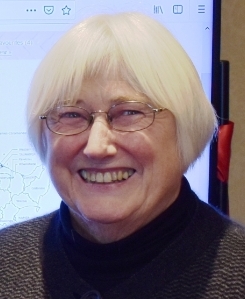"After Notre Dame, we must protect and preserve NZ's landmarks" Stuff Online OP-Ed.
“Hon. Marian Hobbs appointed Heritage New Zealand Board Chair” HNZPT Media Release
18/07/2019

(Image HNZPT)
Heritage New Zealand Pouhere Taonga welcomes the appointment of the Hon. Marian Hobbs as its Board chair, for a three year term that ends on 30 June 2022.
Associate Minister for Arts, Culture and Heritage, Hon Grant Robertson, announced the appointment recently on behalf of the Minister for Arts, Culture and Heritage, Prime Minister Jacinda Ardern.
Marian replaces the Rt Hon. Wyatt Creech who has stepped down after just over five years as Board Chair.
"This very welcome appointment as Chair of Heritage New Zealand Pouhere Taonga continues a lifelong celebration of all that is and has been Aotearoa New Zealand," Marian says.
"I always taught New Zealand literature to my students: I ensured that at least 25 percent of music played on New Zealand radio stations was New Zealand music.
"Like Wyatt, I believe that we know ourselves if we know and understand where we have come from."
Marian was a list member of Parliament from 1996 to 1999 and Member for Wellington Central from 1999 to 2008 before retiring from politics. Prior to this she had an extensive career in education, including seven years as principal of Avonside Girls’ High School in Christchurch. In 1993 she was awarded the New Zealand Suffrage Centennial Medal. Today, Marian is based in Dunedin.
Heritage New Zealand Pouhere Taonga Chief Executive, Andrew Coleman, says the new appointment reflects an appreciation of the importance of heritage in the well-being of all New Zealanders and telling the story of who we are.
"Marian’s appointment will further strengthen and advance the experience, guidance and stewardship that Wyatt provided our organisation. These are exciting times for heritage with strong Government support. Marian brings not only a wealth of knowledge to this position but also a genuine passion for heritage and the arts."
“Easing the impact of earthquake strengthening for provincial New Zealand ” Hon Jenny Salesa (Media Release)

A change to the system for managing earthquake-prone buildings (EPBs) will make it easier for owners of these buildings in small towns to undertake modest building work, without having to start seismic strengthening work at the same time.
(more…)The National Historic Landmarks/Ngā Manawhenua o Aotearoa me ōna Kōrero Tūturu programme
In the the media release by the Hon Grant Robertson :

“New Zealand’s first national historic landmark announced” Hon Grant Robertson Media Release
The following Q&A explanation was included.
The National Historic Landmarks/Ngā Manawhenua o Aotearoa me ōna Kōrero Tūturu programme was introduced by the Heritage New Zealand Pouhere Taonga Act 2014. Heritage New Zealand works in partnership with Manatū Taonga Ministry for Culture and Heritage and other stakeholders including the Department of Conservation to deliver the programme.
Details about National Historic Landmarks is available on the Heritage New Zealand Pouhere Taonga website at: www.heritage.org.nz/the-list/national-historic-landmarks
Questions and Answers
Q 1: What is the National Historic Landmarks programme?
A: The National Historic Landmarks programme was introduced by the Heritage New Zealand Pouhere Taonga Act 2014 (HNZPTA) to acknowledge those places that New Zealanders demonstrably care about as cornerstones of national identity.
Q 2: Haven’t we already got a Landmarks programme?
A:Tohu Whenua is the new name of a tourism programme covering a nationwide regional group of visitor assets. A pilot programme, under the name Landmarks Whenua Tohunga, was initiated in 2015 in Northland. Otago followed with the West Coast included in December 2018 under the new name Tohu Whenua. The National Historic Landmarks programme, in contrast, recognises heritage places of deep significance to New Zealanders as the stories they tell are meaningful and their survival important to us all.
Q 3: Who runs Tohu Whenua?
A: Tohu Whenua is run by Manatū Taonga Ministry for Culture and Heritage, the Department of Conservation and Heritage New Zealand Pouhere Taonga. The aim is to showcase our historic and culturally important places to locals and tourists in a coordinated way. Heritage New Zealand now oversees this programme, with a programme manager based in Wellington.
Q 4: What is the aim of National Historic Landmarks?
A:The aim is to protect heritage places most important to New Zealanders through long-term risk planning and management, including from natural disaster. These places have rich historical, physical, and cultural significance and without them we are losing something special that identifies us as New Zealanders. A key policy objective of National Historic Landmarks is to help prioritise the government’s heritage conservation efforts, including earthquake strengthening.
(more…)“Earthquake-prone buildings changes to help provinces” RNZ News online
"... The Minister for Building and Construction Jenny Salesa announced the change, in Feilding this morning.
She says the changes will make it easier for owners of such buildings in small towns to undertake modest building work, without having to start seismic strengthening work at the same time. ..."
https://www.rnz.co.nz/news/national/394330/earthquake-prone-buildings-changes-to-help-provinces
Heritage In The Budget 2019
The following spending were found in the Budget 2019 documents:
“Overview of Heritage Report Process” MCH Heritge Policy (Team)
Historic Places Aotearoa acknowledges the The MCH Heritage Policy (Team)members who have provided a revised "Overview of Heritge Report Process".
In 2018, Ministers requested the Ministry for Culture and Heritage (MCH) undertake an assessment of New Zealand’s system for protecting heritage buildings and make recommendations on how to enhance the system.
MCH sought input from heritage stakeholders to prepare the assessment. Feedback was gathered through a Colmar Brunton designed survey and workshops in a number of regional centres. Stakeholders included central and local government, iwi, academics, architects, planners, engineers, advocacy bodies, property owners and developers. A total of 293 individuals and organisations provided feedback.
The enthusiastic response to the Ministry’s outreach highlighted some common concerns. Stakeholders focused on improved regulation, increased funding and enhanced information. Many respondents asked for the Crown to demonstrate best practice in relation to its own heritage properties. Stakeholder feedback indicated strong support for some level of Government intervention to improve the current system.
A draft report based on the stakeholder input and policy analysis was circulated to stakeholders for comment. The finalised report and policy advice was then approved by the Minister for Arts, Culture and Heritage. This report has informed the Ministry’s heritage protection work programme for 2019.
MCH is currently in the process of determining the most appropriate means of addressing the issues raised in the report.
MCH thanks stakeholders for being involved in 2018, and looks forward to working with them on the next stage of the assessment as policy options are worked up later this year.










